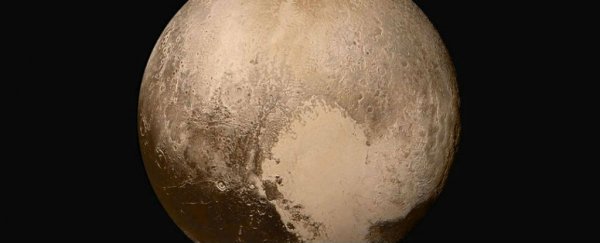NASA scientists have published a manifesto that proposes a new definition of a planet, and if it holds, it will instantly add more than 100 new planets to our Solar System, including Pluto and our very own Moon.
The key change the team is hoping to get approved is that cosmic bodies in our Solar System no longer need to be orbiting the Sun to be considered planets - they say we should be looking at their intrinsic physical properties, not their interactions with stars.
"In keeping with both sound scientific classification and peoples' intuition, we propose a geophysically-based definition of 'planet' that importantly emphasises a body's intrinsic physical properties over its extrinsic orbital properties," the researchers explain.
The team is led by Alan Stern, principle investigator of NASA's New Horizons mission to Pluto, which in 2015 achieved the first-ever fly-by of the controversial dwarf planet.
Pluto was famously 'demoted' to dwarf planet status back in August 2006, when astronomer Mike Brown from the California Institute of Technology (Caltech) proposed a rewrite of the definition of planets.
The International Astronomical Union (IAU), which controls such things, declared that the definition of a planet in our Solar System reads as follows:
"A celestial body that (a) is in orbit around the Sun, (b) has sufficient mass for its self-gravity to overcome rigid body forces so that it assumes a hydrostatic equilibrium (nearly round) shape, and (c) has cleared the neighbourhood around its orbit."
Having not yet cleared the neighbourhood of its orbit in space, Pluto could no longer hold the designation of a planet under these new guidelines.
Stern, who obviously has a great fondness for Pluto, having led the mission that showed us all its adorable heart pattern for the first time, recently called the decision "bullshit".
"Why would you listen to an astronomer about a planet?" Stern, a planetary scientist, pointed out to Kelly Dickerson at Business Insider in 2015.
He said asking an astronomer, who studies a wide variety of celestial objects and cosmic phenomena, rather than a planetary scientist, who focusses solely on planets, moons, and planetary systems, for the definition of a planet is like going to a podiatrist for brain surgery.
"Even though they're both doctors, they have different expertise," Stern said. "You really should listen to planetary scientists that know something about this subject. When we look at an object like Pluto, we don't know what else to call it."
Now, Stern and his colleagues have rewritten the definition of a planet, and are submitting it to the IAU for consideration.
"We propose the following geophysical definition of a planet for use by educators, scientists, students, and the public," they write.
"A planet is a sub-stellar mass body that has never undergone nuclear fusion and that has sufficient self-gravitation to assume a spheroidal shape adequately described by a triaxial ellipsoid regardless of its orbital parameters."
If that's a little too jargony for you, their 'layman's version' is simply: "Round objects in space that are smaller than stars."
The definition sounds incredibly simple, but it's deceptively narrow - there aren't a whole lot of objects objects in the known Universe that would qualify, as it excludes things like stars and stellar objects such as white dwarfs, plus neutron stars and black holes.
"In keeping with emphasising intrinsic properties, our geophysical definition is directly based on the physics of the world itself, rather than the physics of its interactions with external objects," the researchers explain.
This would mean that our Moon, and other moons in the Solar System such as Titan, Enceladus, Europa, and Ganymede, would all qualify as planets, as would Pluto itself, which has already been looking more and more 'planet-like' of late.
The researchers don't just argue that their definition holds more merit than the current one in terms of what properties we should be using to classify a planet - they say the current definition is inherently flawed for several reasons.
- "First, it recognises as planets only those objects orbiting our Sun, not those orbiting other stars or orbiting freely in the galaxy as 'rogue planets'," they explain.
- Second, the fact that it requires zone-clearing means "no planet in our Solar System" can satisfy the criteria, since a number of small cosmic bodies are constantly flying through planetary orbits - including Earth's.
- Finally, and "most severely", they say, this zone-clearing stipulation means the mathematics used to confirm if a cosmic body is actually a planet must be distance-dependent, because a "zone" must be clarified.
This would require progressively larger objects in each successive zone, and "even an Earth-sized object in the Kuiper Belt would not clear its zone".
Of course, nothing changes until the IAU makes a decision, and if it decides to rejig the definition of a planet, either by these recommendations or others in the future, it's going to take a whole lot of deliberating before it becomes official.
But the team claims to have the public on their side, and if this public debate is anything to go on, maybe it's time for a rethink - even if Stern just really wants to stop having to answer the question: "Why did you send New Horizons to Pluto if it's not a planet anymore?"
You can read the proposal in full here.
